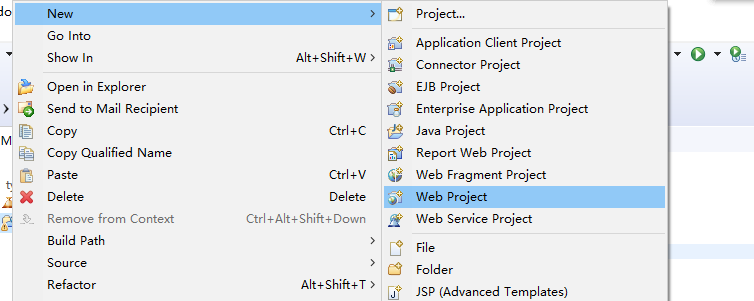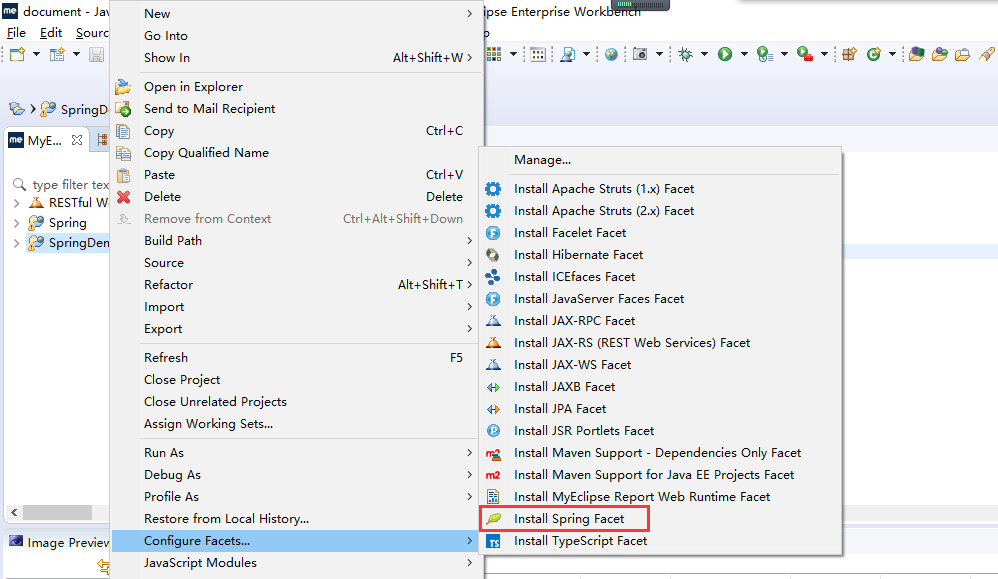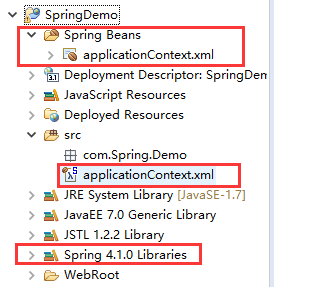使用myeclipse开发spring一个Demo。
第一步:新建一个web project。

第二步:安装spring开发的支持包。

安装后多了这几个东西

3,定义一个操作接口:
package com.Spring.Demo; public interface IFruit { public void eat(); }
4,定义接口操作子类。
package com.Spring.Demo; public class Apple implements IFruit { @Override public void eat() { System.out.println("吃苹果"); } }
随后不提供有工厂的操作类,因为spring本身就有工厂类。在之后的工作就不应该出现工厂类。
5,修改applicationContext.xml文件。
<?xml version="1.0" encoding="UTF-8"?> <beans xmlns="http://www.springframework.org/schema/beans" xmlns:xsi="http://www.w3.org/2001/XMLSchema-instance" xmlns:p="http://www.springframework.org/schema/p" xsi:schemaLocation="http://www.springframework.org/schema/beans http://www.springframework.org/schema/beans/spring-beans-4.1.xsd"> <bean id="apple" class="com.Spring.Demo.Apple"></bean> </beans>
6,随后通过特定模式启动spring容器。
找到子类操作接口。
package com.Spring.Demo; import org.springframework.context.ApplicationContext; import org.springframework.context.support.ClassPathXmlApplicationContext; public class TestApple { public static void main(String[] args) { ApplicationContext ctx=new ClassPathXmlApplicationContext("applicationContext.xml"); IFruit fruit=ctx.getBean("apple",Apple.class); fruit.eat(); } }
整个代码操作过程中无法发现工厂设计模式的明确使用,因为所有的工厂都由spring帮助用户处理了。而且在
applicationContext.XML配置文件里,都在spring容器启动时候默认实例化好了所有的对象。
使用的时候,根据ID名称取出即可。
使用过程中的类:
1,应用上下文类:ApplicationContext
所有配置的信息都需要通过此类读取。
常用方法:getBean(String name,Class<T> requireType)。取得指定名称的bean对象,并且设置泛型为指定操作的bean类型,避免向下转型;
2,由于资源控制文件可能在任意位置上,例如CLASSPATH或者磁盘中,那么必须使用相关子类:
ClassPathXmlApplicationContext("ClassPath");表示在CLASSPATH中读取资源文件。
所有spring配置的<bean>元素都表示在spring容器启动的时候自动初始化,所以在使用对象之前已经准备好了供用户使用的实例,
用户在使用的时候,只需要通过bean的ID,获取对象实例,赋值给对象声明。
如果有更严格的配置也可以把接口配置上去(不过没啥用)
<bean id="fruit" class="com.Spring.Demo.IFruit" abstract="true"></bean> <bean id="apple" class="com.Spring.Demo.Apple" parent="fruit"></bean>
由于接口是抽象的,那么表示接口对象不会进行实例化。而在编写apple元素的时候加上的parent 也只是说明而已。
总结
spring是一个非常庞大的工厂,所有对象的实例化等赋值部分,不需要用户赋值处理了,全部交给spring完成。
用户只需要根据需求引用对象实例即可。